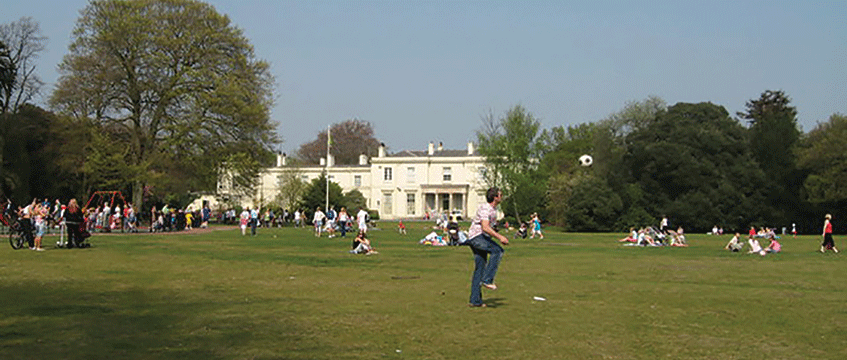Liverpool City Council came under fire recently for granting two planning permissions on part of its “green wedge” site, Calderstones Park (pictured). The Court of Appeal case which followed (R (on the application of Liverpool Open & Green Spaces Community Interest Co) v Liverpool City Council [2020] EWCA Civ 861; [2020] PLSCS 136) is noteworthy because it sets out how decision-makers should approach local policy and reminds us that important consultation responses from experts should always be passed on to members.
The first permission allowed 39 new homes and the conversion of two listed buildings into 12 apartments. The second permission authorised the relocation of a miniature railway. The permissions were challenged by the Liverpool Open and Green Spaces Community Interest Co, which had objected to both planning applications.
The challenge was initially successful, and both planning permissions were quashed by the High Court, but the council appealed. The Court of Appeal had to decide whether:
- the appeal was academic;
- the council misinterpreted and misapplied its local green wedge policy in granting permission; and
- the council failed to comply with its legal duty in respect of the listed buildings.
Was the appeal academic?
One of the things that makes this case particularly interesting is that it took place despite the council saying that, even if it won, neither permission would be implemented. This was partly because the mayor of Liverpool had publicly declared that the housing scheme would not go ahead and, as the council owned the land, it could control implementation.
The case concerned such important planning principles that the council wanted to get the Court of Appeal’s take on its approach. The court agreed that it was in the public interest for the case to be heard. This was largely because the case was about the interpretation of planning policy that had not been considered before and which had “potential consequences” not just across Liverpool, but in other parts of the country where similar green wedge policies are in place.
Did the council misinterpret and misapply its green wedge policy?
The case centred on Liverpool’s green wedge policy OE3 which says that the council will “protect and improve the open character, landscape, recreational and ecological quality” of the green wedge. It goes on to explain that permission will not be granted for new development that affects the “predominantly open character” of the green wedge or which reduces the gap between built up areas. It also sets out the criteria that must be complied with where new built development is permitted and describes how it will keep land it owns in “predominantly open use”.
So was the policy misinterpreted and misapplied? The Court of Appeal said not. This was green wedge, not green belt policy. The city’s hierarchy of open land made a distinction between the two. Unlike the High Court, Lindblom LJ held that “open character” in policy OE3 was a qualified, rather than an absolute concept. The predominantly open character of a green wedge is for the decision-maker to judge.
The officer was praised for applying the policy lawfully “in a sequence of rational and clearly reasoned conclusions”. Two key takeaways are: (1) the importance of “context” in interpreting policy and not reading extra words into it; and (2) the need to explain one’s interpretation in a logical way, applying it to the specifics of the proposed development. For example, the officer explained the existing site characteristics and how the proposal had regarded openness, citing the spacious layout, low density and retention of landscape features as visual breaks.
Did the council comply with its legal duty in respect of the listed buildings?
Sadly, this is where the good news for the council ended. The court found that the duty had not been complied with in respect of the first permission for the housing scheme. Section 66(1) of the Planning (Listed Buildings and Conservation Areas) Act 1990 required the council to have special regard to the desirability of preserving the listed buildings and their setting. Established case law provides that if the proposed development would be likely to “harm” the listed buildings or setting, the council must give this “considerable importance and weight”.
So what went wrong? The council’s heritage and conservation team’s consultation response had objected firmly because of the adverse impact on the setting of the Grade II listed house. The planning officer failed to tell council members about this response. This left the judge in doubt as to whether the section 66(1) duty had been complied with, because members were not properly informed of the opinion of those with such expertise on the point, namely the heritage and conservation team.
Always ask the expert
Lindblom LJ highlighted the significance of consultation responses, particularly where national planning policy advises councils to take into account “any necessary expertise”. As that is the case for heritage assets, it was really important in this case for the experts’ views to be considered by the members when deciding the planning application.
Without any evidence that this was done, the court was not persuaded that the section 66(1) duty had been complied with and that members knew to give “considerable importance and weight” to the harm identified by the heritage and conservation team. While the miniature railway permission was reinstated, the quashing of the housing scheme permission was upheld. So the mayor of Liverpool was right: the housing scheme would not go ahead, but at least we’re all a bit clearer on how green wedge policy should be approached – and when we should pass on expert heritage opinion to members: always.
Kathryn Hampton is a senior expertise lawyer at Ashurst LLP








